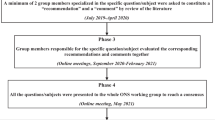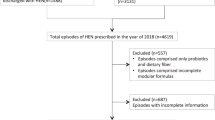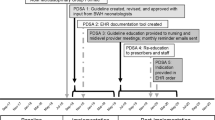Abstract
Unsafe medication practices and medication errors are leading causes of injury and avoidable harm worldwide and are highest in vulnerable groups. In 2017, the World Health Organization launched the third Medication Without Harm Global Patient Safety Challenge to try to reduce risks related to medical treatment. Parenteral nutrition (PN) is in the unique position that, although licensed products are available from manufacturers, formulas may be prepared ad hoc for first-line use that might not be subject to the same regulatory oversight. Safety issues around PN can arise through lack of harmonization in practices, misinterpretation and product unfamiliarity and can occur at any stage from prescription to preparation to administration. Government legislation and regulation vary considerably, with PN not explicitly handled in many countries. We therefore call on policy leaders in all countries to establish policies that ensure patient safety, and that these include PN along with medicines. The available evidence supports obtaining industry prepared PN as first-line therapy for reasons of safety, primarily, and of cost. If a suitable industry prepared ready-to-use PN is not available, standardized all-in-one PN admixtures should be the next line of care, with individualized PN being reserved for patients whose complex nutritional needs cannot be met using standardized admixtures.
This is a preview of subscription content, access via your institution
Access options
Subscribe to this journal
Receive 12 print issues and online access
$259.00 per year
only $21.58 per issue
Buy this article
- Purchase on Springer Link
- Instant access to full article PDF
Prices may be subject to local taxes which are calculated during checkout


Similar content being viewed by others
References
Donaldson LJ, Kelley ET, Dhingra-Kumar N, Kieny M-P, Sheikh A. Medication without harm: WHO’s third global patient safety challenge. Lancet. 2017. https://doi.org/10.1016/S0140-6736(17)31047-4
Riskin A, Picaud J-C, Shamir R. ESPGHAN/ESPEN/ESPR/CSPEN guidelines on pediatric parenteral nutrition: Standard versus individualized parenteral nutrition. Clin Nutr. 2018;37:2409–17. https://doi.org/10.1016/j.clnu.2018.06.955
Singer P, Reintam Blaser A, Berger MM, Alhazzani W, Calder PC, Casaer MP, et al. ESPEN guideline on clinical nutrition in the intensive care unit. Clin Nutr. 2019;38:48–79. https://doi.org/10.1016/j.clnu.2018.08.037
Boullata JI, Gilbert K, Sacks G, Labossiere RJ, Crill C, Goday P, et al. A.S.P.E.N. clinical guidelines: parenteral nutrition ordering, order review, compounding, labeling, and dispensing. J Parenter Enter Nutr. 2014;38:334–77. https://doi.org/10.1177/0148607114521833
Williams DJP. Medication errors. J R Coll Physicians Edinb. 2007;37:343–6.
Cousins DH, Gerret D, Warner B. A review of medication incidents reported to the National Reporting and Learning System in England and Wales over 6 years (2005-2010). Br J Clin Pharm. 2012;74:597–604. https://doi.org/10.1111/j.1365-2125.2011.04166.x
Lewis PJ, Dornan T, Taylor D, Tully MP, Wass V, Ashcroft DM. Prevalence, incidence and nature of prescribing errors in hospital inpatients: a systematic review. Drug Saf. 2009;32:379–89. https://doi.org/10.2165/00002018-200932050-00002
Cowley E, Williams R, Cousins D. Medication errors in children. A descriptive summary of medication error reports submitted to the United States Pharmacopeia. Curr Ther Resid. 2001;26:627–40.
Sears K, Ross-White A. The incidence, prevalence and contributing factors associated with the occurrence of medication errors for children and adults in the community setting: a systematic review. JBI Libr Syst Rev. 2010;8:1–12.
Keers RN, Williams SD, Cooke J, Ashcroft DM. Causes of medication administration errors in hospitals: a systematic review of quantitative and qualitative evidence. Drug Saf. 2013;36:1045–67. https://doi.org/10.1007/s40264-013-0090-2
Valentin A, Capuzzo M, Guidet B, Moreno RP, Dolanski L, Bauer P, et al. Patient safety in intensive care: results from the multinational Sentinel Events Evaluation (SEE) study. Intensive Care Med. 2006;32:1591–8. https://doi.org/10.1007/s00134-006-0290-7
Valentin A, Capuzzo M, Guidet B, Moreno R, Metnitz B, Bauer P, et al. Errors in administration of parenteral drugs in intensive care units: multinational prospective study. BMJ. 2009;338:b814 https://doi.org/10.1136/bmj.b814
Institute for Safe Medical Practices. ISMP list of high-alert medications in acute care settings. Horsham, UK: Institute for Safe Medical Practices; 2018.
Koper D, Kamenski G, Flamm M, Böhmdorfer B, Sönnichsen A. Frequency of medication errors in primary care patients with polypharmacy. Fam Pract. 2013;30:313–9. https://doi.org/10.1093/fampra/cms070
Stavroudis TA, Miller MR, Lehmann CU. Medication errors in neonates. Clin Perinatol. 2008;35:141–61. https://doi.org/10.1016/j.clp.2007.11.010
Rothschild JM, Landrigan CP, Cronin JW, Kaushal R, Lockley SW, Burdick E, et al. The Critical Care Safety Study: the incidence and nature of adverse events and serious medical errors in intensive care. Crit Care Med. 2005;33:1694–1700. https://doi.org/10.1097/01.CCM.0000171609.91035.BD
World Health Organization. Medication errors: technical series on safer primary care. Geneva: World Health Organization; 2016.
National Coordinating Council for Medication Error Reporting and Prevention. About medication errors: what is a medication error? 2019. https://www.nccmerp.org/about-medication-errors. Accessed 4 June 2019.
European Medicines Agency. Recommendations on medication errors. 2015. https://www.ema.europa.eu/en/human-regulatory/post-authorisation/pharmacovigilance/medication-errors/recommendations-medication-errors. Accessed June 2019.
White R. Parenteral nutrition for adults—an overview of the basic principles. Clin Pharm. 2011;3:183–4.
Worthington P, Balint J, Bhechtold M, Bingham A, Chan LN, Durfee S, et al. When is parenteral nutrition appropriate? J Parenter Enter Nutr. 2017;41:324–77. https://doi.org/10.1177/0148607117695251
Alfonso JE, Berlana D, Ukleja A, Boullata J. Clinical, ergonomic, and economic outcomes with multichamber bags compared with (hospital) pharmacy compounded bags and multibottle systems: a systematic literature review. J Parenter Enter Nutr. 2017;41:1162–77. https://doi.org/10.1177/0148607116657541
Radziwill R. All-in-one vs. single bottle systems. In: Weimann A, Schütz T, Ohlrich S, Fedders M, Grünewald G. Ernährungsmedizin – Ernährungsmanagement—Ernährungstherapie. Weinheim: Ecomed Medizin, 2019:168–72.
Holcombe B, Mattox TW, Plogsted S. Drug shortages: effect on parenteral nutrition therapy. Nutr Clin Pract. 2018;33:53–61. https://doi.org/10.1002/ncp.10052
Chhim RF, Crill CM. Premixed parenteral nutrition solution use in children. J Pediatr Pharm Ther. 2015;20:378–84. https://doi.org/10.5863/1551-6776-20.5.378
Colomb V, Marlowe ML, Bonnot D, Rigo J. Practical use of a new three-chamber bag for parenteral nutrition in pediatric patients. Clin Nutr. 2012;7:e93–e99. https://doi.org/10.1016/j.clnme.2012.01.002
Maisonneuve N, Raguso CA, Paoloni-Giacobino A, Mühlebach S, Corriol O, Saubion JL, et al. Parenteral nutrition practices in hospital pharmacies in Switzerland, France, and Belgium. Nutrition. 2004;20:528–35. https://doi.org/10.1016/j.nut.2004.03.020
Mena KDR, Espitia OLP, Bergara JAD. Management of ready-to-use parenteral nutrition in newborns: systematic review. J Parenter Enter Nutr. 2018;42:1123–32. https://doi.org/10.1002/jpen.1165
Singh A, Rauch D. Commercial premixed parenteral nutrition and its potential role in pediatrics. Hospital Pediatr. 2016;6:34–36. https://doi.org/10.1542/hpeds.2015-0147
Simmer K, Rakshasbhuvankar A, Deshpande G. Standardised parenteral nutrition. Nutrients. 2013;5:1058–70. https://doi.org/10.3390/nu5041058
Blanchette LM, Huiras P, Papadoulos S. Standardized versus custom parenteral nutrition: impact on clinical and cost-related outcomes. Am J Health Syst Pharm. 2013;2:114–21. https://doi.org/10.2146/ajhp120733
Berlana D, Almendral MA, Abad MR, Fernández A, Torralba A, Cervera-Peris M, et al. Cost, time, and error assessment during preparation of parenteral nutrition: multichamber bags versus hospital-compounded bags. J Parenter Enter Nutr. 2019;43:557–65. https://doi.org/10.1002/jpen.1436
Berlana D, Barraquer A, Sabin P, Chicharro L, Pérez A, Puiggrós C, et al. Impact of parenteral nutrition standardization on costs and quality in adult patients. Nutr Hosp. 2014;30:351–8. https://doi.org/10.3305/nh.2014.30.2.7575
Yu J, Wu G, Tang Y, Ye Y, Zhang Z. Efficacy, safety, and preparation of standardized parenteral nutrition regimens: three-chamber bags vs compounded monobags-a prospective, multicenter, randomized, single-blind clinical trial. Nutr Clin Pr. 2017;32:545–51. https://doi.org/10.1177/0884533617701883
Pironi L, Steiger E, Brandt C, Joly F, Wanten G, Chambrier C, et al. Home parenteral nutrition provision modalities for chronic intestinal failure in adult patients: an international survey. Clin Nutr. 2019;39:585–91. https://doi.org/10.1016/j.clnu.2019.03.010
Boullata JI, Guenter P, Mirtallo JM. A parenteral nutrition use survey with gap analysis. J Parenter Enter Nutr. 2013;37:212–22. https://doi.org/10.1177/0148607112464781
Sacks GS, Rough S, Kudsk KA. Frequency and severity of harm of medication errors related to the parenteral nutrition process in a large university teaching hospital. Pharmacotherapy. 2009;29:966–74. https://doi.org/10.1592/phco.29.8.966
Arenas Villafranca JJ, Gómez Sánchez A, Nieto Guindo M, Faus Felipe V. Using failure mode and effects analysis to improve the safety of neonatal parenteral nutrition. Am J Health Syst Pharm. 2014;71:1210–8. https://doi.org/10.2146/ajhp130640
Bateman R, Donyai P. Errors associated with the preparation of aseptic products in UK hospital pharmacies: lessons from the national aseptic error reporting scheme. Qual Saf Health Care. 2010;19:e29 https://doi.org/10.1136/qshc.2009.034751
MacKay M, Anderson C, Boehme S, Cash J, Zobell J. Frequency and severity of parenteral nutrition medication errors at a large children’s hospital after implementation of electronic ordering and compounding. Nutr Clin Pr. 2016;31:195–206. https://doi.org/10.1177/0884533615591606
Li Q, Kirkendall ES, Hall ES, Ni Y, Lingren T, Kaiser M, et al. Automated detection of medication administration errors in neonatal intensive care. J Biomed Inform. 2015;57:124–33. https://doi.org/10.1016/j.jbi.2015.07.012
Nguyen M-NR, Mosel C, Grzeskowiak LE. Interventions to reduce medication errors in neonatal care: a systematic review. Ther Adv Drug Saf. 2018;9:123–55. https://doi.org/10.1177/2042098617748868
Hermanspann T, Schoberer M, Robel-Tillig E, Härtel C, Goelz R, Orlikowsky T, et al. Incidence and severity of prescribing errors in parenteral nutrition for pediatric inpatients at a neonatal and pediatric intensive care unit. Front Pediatr. 2017;5:149 https://doi.org/10.3389/fped.2017.00149
Mendes JR, Lopes MCBT, Vancini-Campanharo CR, Okuno MFP, Batista REA. Types and frequency of errors in the preparation and administration of drugs. Einstein. 2018;16:eAO4146 https://doi.org/10.1590/S1679-45082018AO4146
De Weerdt E, Simoens S, Hombroeckx L, Casteels M, Huys I. Causes of drug shortages in the legal pharmaceutical framework. Regul Toxicol Pharm. 2015;71:251–8. https://doi.org/10.1016/j.yrtph.2015.01.005
Guenter P, Worthington P, Ayers P, Boullata JI, Gura KM, Marshall N, et al. Standardized competencies for parenteral nutrition administration: the ASPEN Model. Nutr Clin Pract. 2015;30:570–6. https://doi.org/10.1002/ncp.10055
Hicks RW, Becker SC, Chuo J. A summary of NICU fat emulsion medication errors and nursing services: data from MEDMARX. Adv Neonatal Care. 2007;7:299–308. https://doi.org/10.1097/01.ANC.0000304969.23837.95
NHS Improvement. Patient safety alert: risk of severe harm and death from infusing total parenteral nutrition too rapidly in babies. September 2017. https://improvement.nhs.uk/documents/1756/Patient_Safety_Alert_-_TPN_in_babies_FINAL.pdf. Accessed June 2019.
Wollitz A, Grissinger M. Aligning the line: an analysis of IV line errors. PA Patient Saf Advis. 2014;11:1–7.
World Health Organization. Medication without harm: WHO patient safety challenge. Geneva: World Health Organization; 2017.
Cederholm T, Barazzoni R, Austin P, Ballmer P, Biolo G, Bischoff SC, et al. ESPEN guidelines on definitions and terminology of clinical nutrition. Clin Nutr. 2017;36:49–64. https://doi.org/10.1016/j.clnu.2016.09.004
Freijer K, Volger S, Pitter JG, Molsen-David E, Cooblall C, Evers S, et al. Medical nutrition terminology and regulations in the United States and Europe—a scoping review: report of the ISPOR Nutrition Economics Special Interest Group. Value Health. 2019;22:1–12. https://doi.org/10.1016/j.jval.2018.07.879
US Food and Drug Administration. Human Drug Compounding. 2017. https://www.fda.gov/drugs/guidance-compliance-regulatory-information/human-drug-compounding. Accessed 4 June 2019.
Author information
Authors and Affiliations
Contributions
Valery Gallagher: conceptualization, methodology, supervision. David Berlana: writing—review and editing, validation. Mattias Paulsson: writing—review and editing, validation. Rebecca White: methodology, writing—original draft.
Corresponding author
Ethics declarations
Conflict of interest
VG is an employee of Baxter Healthcare and, presently serves as a member of the American Society of Parenteral and Enteral Nutrition’s (ASPEN) Corporate Scientific Advisory Council. MP reports personal fees from InBioPharma US/Baxter, Fresenius Kabi Germany, and B Braun Sweden outside the submitted work. DB reports personal fees from Fresenius Kabi and Baxter SL outside the submitted work. RJW is an employee of Baxter Healthcare and is the communication officer for the British Pharmaceutical Nutrition Group.
Additional information
Publisher’s note Springer Nature remains neutral with regard to jurisdictional claims in published maps and institutional affiliations.
Supplementary information
Rights and permissions
About this article
Cite this article
Gallagher, V., Berlana, D., Paulsson, M. et al. Parenteral nutrition: a call to action for harmonization of policies to increase patient safety. Eur J Clin Nutr 75, 3–11 (2021). https://doi.org/10.1038/s41430-020-0669-5
Received:
Revised:
Accepted:
Published:
Issue Date:
DOI: https://doi.org/10.1038/s41430-020-0669-5
This article is cited by
-
Medication errors related to high-alert medications in a paediatric university hospital – a cross-sectional study analysing error reporting system data
BMC Pediatrics (2023)
-
Offering Guidance and Learning to Prescribers to Initiate Parenteral Nutrition using a Validated Electronic Decision TREE (OLIVE TREE)
Journal of Medical Systems (2022)



